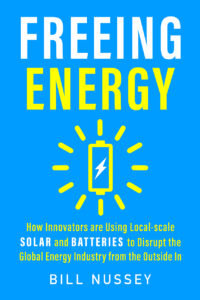 If you want to understand the causes of global climate change and what can be done to reverse it, you should start by reading Drawdown – The Most Comprehensive Plan Ever Proposed to Reverse Global Warming. This book is part of a broader project led by famed environmentalist, speaker, entrepreneur, and activist, Paul Hawken. He and his colleagues collaborated with hundreds of researchers to wade through mountains of scientific studies. Together they organized, analyzed, and explained 100 digestible, data-driven solutions for reversing climate change.
If you want to understand the causes of global climate change and what can be done to reverse it, you should start by reading Drawdown – The Most Comprehensive Plan Ever Proposed to Reverse Global Warming. This book is part of a broader project led by famed environmentalist, speaker, entrepreneur, and activist, Paul Hawken. He and his colleagues collaborated with hundreds of researchers to wade through mountains of scientific studies. Together they organized, analyzed, and explained 100 digestible, data-driven solutions for reversing climate change.
The book is not a quick read but its structure makes it easy to scan and dive deeply into the parts that interest you. The solutions are organized into major sections like electricity, food, buildings, and land use. Each solution is a mixture of data, beautiful pictures, and engaging stories that bring the solution to life. It’s interspersed with contributions by other well-respected sustainability leaders.
GET MONTHLY NEWS & ANALYSIS
Unsubscribe anytime. We will never sell your email or spam you.
My first introduction to the book came from its primary author and fellow Atlanta-native, Katharine Wilkinson. While our original meeting was to get her advice on authoring a book, the magnitude and scope of the Drawdown project were perhaps, even more, engaging for me. In the months since the book’s release, Katharine has become one of the main faces of the project (check out her speech at Google on Project Drawdown).
Big surprises
The power of a book like this comes from its surprises. Yes, of course, coal plants and deforestation are huge contributors to greenhouse gas levels but you might be surprised to learn the #1 solution to climate change is: refrigeration. If your curiosity is piqued, then you will definitely enjoy the book.
Clean energy makes a few of the top 10 slots: wind turbines #2, solar farms #9 and rooftop solar #10). But it was the solutions in between that surprised me the most:
- Educating girls is #6 – in the developing parts of the world, children’s education often falls outside the priority list, particularly for girls. Education in areas like farming, healthcare, cooking, and reproductive health have huge long-term impacts on economic development and ultimately climate change.
- While each area is listed separately in the book, the aggregate climate impact of livestock, farming, deforestation, and food waste becomes the single largest solution to climate change (If cattle were their own nation, they would be the world’s third-largest emitter of greenhouse gases – cattle and other ruminants require more than one-third the world’s arable land and produce about one-fifth of the greenhouse gases).
- The building sector worldwide uses approximately 32 percent of all energy generated. More than one-third of that is for heating and cooling.
- Concrete creates 5-6 percent of all greenhouse gases and, although it is not universally used, the fly ash from coal power plants can actually replace CO2 intensive components of the traditional cement manufacturing process.
The most surprising takeaway from Drawdown was the book’s view of nuclear power. Many climate researchers and advocates see nuclear as a high priority for deterring climate change. Hawken’s and the Project Drawdown team take a different view (from the book):
EDITOR’S NOTE: One hundred solutions are featured in Drawdown. Of those, almost all are no-regrets solutions society would want to pursue regardless of their carbon impact because they have many beneficial social, environmental, and economic effects. Nuclear is a regrets solution, and regrets have already occurred at Chernobyl, Three Mile Island, Rocky Flats, Kyshtym, Browns Ferry, Idaho Falls, Mihama, Lucens, Fukushima Daiichi, Tokaimura, Marcoule, Windscale, Bohunice, and Church Rock. Regrets include tritium releases, abandoned uranium mines, mine-tailings pollution, spent nuclear waste disposal, illicit plutonium trafficking, thefts of fissile material, destruction of aquatic organisms sucked into cooling systems, and the need to heavily guard nuclear waste for hundreds of thousands of years.
(I’ll be posting a deep-dive on nuclear as well as Freeing Energy’s perspective on it in the coming weeks).
Climate change isn’t just about energy but energy matters a lot
Overall, reversing climate change is a lot more about how we chose to live our lives than the way we design the machines that make our lives more convenient. Energy-based solutions only make one of the top five Drawdown ideas for reducing greenhouse gases. There are far more non-energy focused solutions can (and should) undertake with our institutions and our own efforts to combat climate change.

But when you change the sort order from GHG emissions to economic value, something amazing happens: energy-related solutions show themselves to be the most profitable way to reduce climate change. For those of us in the world of energy, reducing climate change is not just a moral imperative, it is also incredibly profitable.

![]()
People ask me why I left the world of enterprise software. The data from Drawdown answers the question better than I can – shifting the world to clean energy is not only the largest business opportunity in history, it’s also one of the most effective ways to reduce the threat of climate change.
![]()
Additional reading on Drawdown
- Sample the first 20 pages of Drawdown
- Check out the extensive information available on the Project Drawdown site including the interactive chart of top-ranked solutions
- Buy the book on Amazon
Additional reading on climate change
Despite a staggering amount of research and writing, climate change has become a surprisingly divisive topic. The Freeing Energy Project is largely focused on the economics of clean energy and can’t add much to the conversations on climate. However, if you’re interested in dipping your toe in the water, here are two dramatically different perspectives that will help you see the range of issues.
A New York Magazine article from 2017 called, The Uninhabitable Earth, will most likely terrify you and keep you from sleeping for a few nights.
I believe that if you want to drive change, you have to understand your challenger’s viewpoint. You can read this Breitbart article citing hundreds of 2017 studies saying global warming is not caused by humans. You can also read Snopes.com response to the original Breitbart article.



